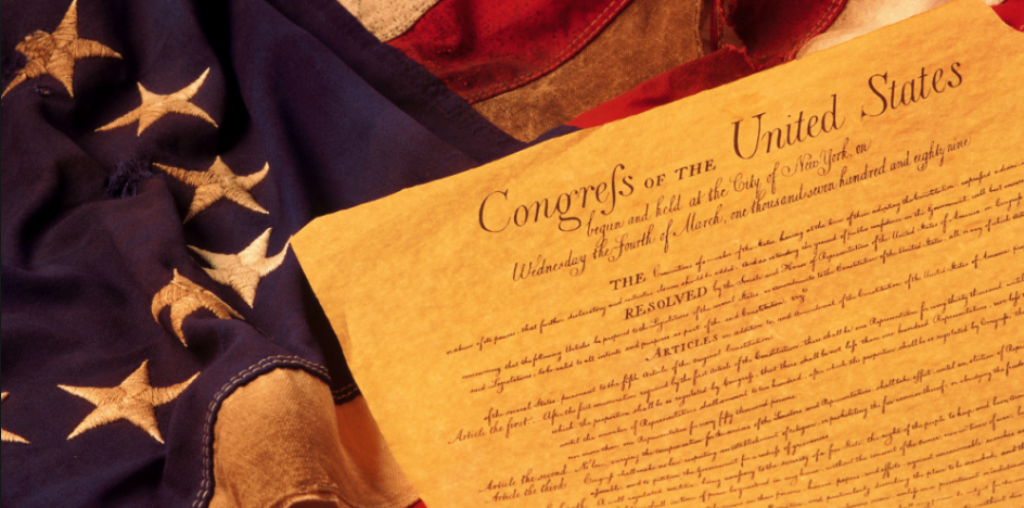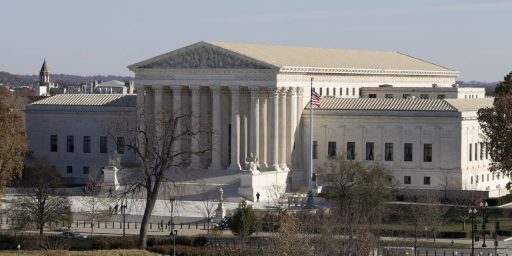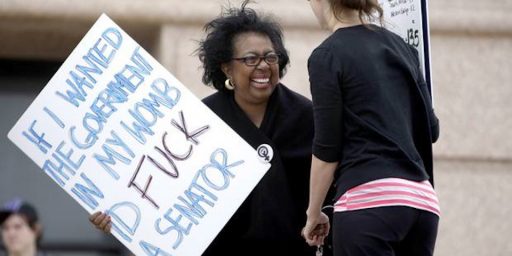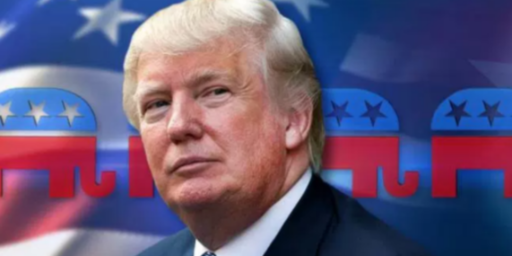Supreme Court Strikes Down Ban On “Political Apparel” At Polling Places
In a significant First Amendment ruling, the Supreme Court has held that a Minnesota law barring "political apparel" at polling places is unconstitutional.

The Supreme Court has struck down a Minnesota law that barred voters from wearing “political apparel” at a polling place, finding that the law violated the First Amendment:
WASHINGTON — The Supreme Court on Thursday struck down a Minnesota law that prohibits voters from wearing T-shirts, hats and buttons expressing political views at polling places.
In a cautious 7-to-2 decision, the court acknowledged the value of decorum and solemn deliberation as voters prepare to cast their ballots. But Chief Justice John G. Roberts Jr. wrote that Minnesota’s law was not “capable of reasoned application.”
Minnesota’s law, similar to ones in about nine other states, is quite broad. It says that “a political badge, political button or other political insignia may not be worn at or about a polling place on primary or Election Day.”
As enforced by election officials, the law bans even general political messages on apparel, like support for gun rights or labor unions.
The goal, state officials have said, is “an orderly and controlled environment without confusion, interference or distraction.”
The case started when members of the Minnesota Voters Alliance, which says it works to ensure “election integrity,” turned up at Minnesota polling places wearing T-shirts bearing Tea Party logos and buttons saying “Please I.D. Me.”
They were told to cover the messages and were allowed to vote even if they refused. But they risked prosecution for disobeying poll workers’ orders.
The group and two individuals challenged the law on free speech grounds, and they lost in the United States Court of Appeals for the Eighth Circuit, in St. Louis.
“Even if Tea Party apparel is not election-related, it is not unreasonable to prohibit it in a polling place,” Judge Duane Benton wrote. “In order to ensure a neutral, influence-free polling place, all political material is banned.”
Chief Justice Roberts said that went too far. States remain free to decide that “some forms of advocacy should be excluded from the polling place,” he wrote. He cited with seeming approval more focused laws in California and Texas aimed at classic electioneering.
“Casting a vote is a weighty civic act, akin to a jury’s return of a verdict, or a representative’s vote on a piece of legislation,” the chief justice wrote. “It is a time for choosing, not campaigning. The state may reasonably decide that the interior of the polling place should reflect that distinction.”
But Minnesota, Chief Justice Roberts wrote, had failed to “articulate some sensible basis for distinguishing what may come in from what must stay out.”
There is no problem with banning items supporting or opposing candidates or ballot measures, he indicated. But Minnesota also barred materials “designed to influence or impact voting,” which officials interpreted to cover messages touching on any subject that had been addressed by candidates and their parties.
“A rule whose fair enforcement requires an election judge to maintain a mental index of the platforms and positions of every candidate and party on the ballot is not reasonable,” Chief Justice Roberts wrote.
Amy Howe summarizes the opinion for SCOTUSBlog:
In an opinion by Chief Justice John Roberts, the majority emphasized that states have the right to try to ensure a peaceful polling place. Moreover, because polling places are, “at least on Election Day, government-controlled property set aside for the sole purpose of voting,” restrictions on speech there are subject to a relatively low bar: The restrictions simply have to be reasonable.
But Minnesota’s ban on “political” apparel fails even that “forgiving” test, the majority concluded, because both the text of the law and the state’s interpretations of it provide so little guidance about what kind of apparel may or may not be worn to the polls. For example, the court observed, the word “political” could include “a button or T-shirt merely imploring others to ‘Vote!'” And some of the state’s efforts to provide more guidance on what apparel is allowed, through a policy distributed in 2010, the court suggested, may make things murkier, rather than clearer. The court noted that the policy would bar “issue oriented material designed to influence or impact voting,” such as the “Please I.D. Me” buttons worn by Cilek and his colleagues, even though there was no voter I.D. requirement on the ballot. “A rule whose fair enforcement requires an election judge to maintain a mental index of the platforms and positions of every candidate and party on the ballot is not reasonable,” the court stressed.
After lamenting the lack of guidance in the Minnesota law at issue, the court then tried to provide a little guidance of its own. While making clear that it was not endorsing the constitutionality of such laws, the court noted that other states restrict apparel at the polls “in more lucid terms”: California bars signs and apparel that advocate for or against candidates or measures on the ballot, and Texas prohibits apparel “relating to a candidate, measure, or political party appearing on the ballot, or to the conduct of the election.” The court also appeared to confirm in a footnote that states “may prohibit messages intended to mislead voters about voting requirements and procedures.” But here, the court concluded, Minnesota has not provided the kind of “objective, workable standards” needed to pass muster under the First Amendment.
Eugene Volokh, who has written extensively on the First Amendment, does the same, and the words of Chief Justice Roberts that he quotes are worth sharing:
[T]he statute prohibits wearing a “political badge, political button, or other political insignia.” It does not define the term “political.” And the word can be expansive. It can encompass anything “of or relating to government, a government, or the conduct of governmental affairs,” Webster’s Third New International Dictionary 1755 (2002), or anything “[o]f, relating to, or dealing with the structure or affairs of government, politics, or the state,” American Heritage Dictionary 1401 (3d ed. 1996). Under a literal reading of those definitions, a button or T-shirt merely imploring others to “Vote!” could qualify.
The State argues that the apparel ban should not be read so broadly. According to the State, the statute does not prohibit “any conceivably ‘political’ message” or cover “all ‘political’ speech, broadly construed.” Instead, the State interprets the ban to proscribe “only words and symbols that an objectively reasonable observer would perceive as conveying a message about the electoral choices at issue in [the] polling place.”
At the same time, the State argues that the category of “political” apparel is not limited to campaign apparel. After all, the reference to “campaign material” in the first sentence of the statute—describing what one may not “display” in the buffer zone as well as inside the polling place—implies that the distinct term “political” should be understood to cover a broader class of items. As the State’s counsel explained to the Court, Minnesota’s law “expand[s] the scope of what is prohibited from campaign speech to additional political speech.” …
[F]ar from clarifying the indeterminate scope of the political apparel provision, the State’s “electoral choices” construction introduces confusing line-drawing problems. For specific examples of what is banned under its standard, the State points to the 2010 Election Day Policy—which it continues to hold out as authoritative guidance regarding implementation of the statute. The first three examples in the Policy are clear enough: items displaying the name of a political party, items displaying the name of a candidate, and items demonstrating “support of or opposition to a ballot question.”
But the next example—“[i]ssue oriented material designed to influence or impact voting”—raises more questions than it answers. What qualifies as an “issue”? The answer, as far as we can tell from the State’s briefing and argument, is any subject on which a political candidate or party has taken a stance. For instance, the Election Day Policy specifically notes that the “Please I. D. Me” buttons are prohibited. But a voter identification requirement was not on the ballot in 2010, so a Minnesotan would have had no explicit “electoral choice” to make in that respect. The buttons were nonetheless covered, the State tells us, because the Republican candidates for Governor and Secretary of State had staked out positions on whether photo identification should be required.
A rule whose fair enforcement requires an election judge to maintain a mental index of the platforms and positions of every candidate and party on the ballot is not reasonable. Candidates for statewide and federal office and major political parties can be expected to take positions on a wide array of subjects of local and national import. Would a “Support Our Troops” shirt be banned, if one of the candidates or parties had expressed a view on military funding or aid for veterans? What about a “#MeToo” shirt, referencing the movement to increase awareness of sexual harassment and assault? At oral argument, the State indicated that the ban would cover such an item if a candidate had “brought up” the topic.
The next broad category in the Election Day Policy—any item “promoting a group with recognizable political views”—makes matters worse. The State construes the category as limited to groups with “views” about “the issues confronting voters in a given election.” The State does not, however, confine that category to groups that have endorsed a candidate or taken a position on a ballot question.
Any number of associations, educational institutions, businesses, and religious organizations could have an opinion on an “issue[] confronting voters in a given election.” For instance, the American Civil Liberties Union, the AARP, the World Wildlife Fund, and Ben & Jerry’s all have stated positions on matters of public concern. If the views of those groups align or conflict with the position of a candidate or party on the ballot, does that mean that their insignia are banned?’
(…)
The State’s “electoral choices” standard, considered together with the nonexclusive examples in the Election Day Policy, poses riddles that even the State’s top lawyers struggle to solve. A shirt declaring “All Lives Matter,” we are told, could be “perceived” as political. How about a shirt bearing the name of the National Rifle Association? Definitely out. That said, a shirt displaying a rainbow flag could be worn “unless there was an issue on the ballot” that “related somehow … to gay rights.”
A shirt simply displaying the text of the Second Amendment? Prohibited. But a shirt with the text of the First Amendment? “It would be allowed.”
“[P]erfect clarity and precise guidance have never been required even of regulations that restrict expressive activity.” But the State’s difficulties with its restriction go beyond close calls on borderline or fanciful cases. And that is a serious matter when the whole point of the exercise is to prohibit the expression of political views.
It is “self-evident” that an indeterminate prohibition carries with it “[t]he opportunity for abuse, especially where [it] has received a virtually open-ended interpretation.” Election judges “have the authority to decide what is political” when screening individuals at the entrance to the polls. We do not doubt that the vast majority of election judges strive to enforce the statute in an evenhanded manner, nor that some degree of discretion in this setting is necessary. But that discretion must be guided by objective, workable standards. Without them, an election judge’s own politics may shape his views on what counts as “political.” And if voters experience or witness episodes of unfair or inconsistent enforcement of the ban, the State’s interest in maintaining a polling place free of distraction and disruption would be undermined by the very measure intended to further it.
In approaching this case, of course, the Justices were forced to balance two important but competing interests.
Of primary concern, of course, is the First Amendment and the fact that the law in question clearly appears to be an obvious content-based regulation of speech. Generally speaking has been skeptical of nearly any content-based regulation of speech This is especially true when the speech at issue is political in nature, and it has been even more true of the Court in the years since John Roberts became Chief Justice, which, despite its conservative reputation, has handed down some of the most far-reaching First Amendment cases since the years of the Warren Court. For example, in recent years, the Court has set aside a civil verdict against the Westboro Baptist Church on the ground that even offensive speech is protected by the First Amendment, struck down a law that made it a crime to falsely claim military honors, struck down a California law restricting the sale of “violent” video games, allowed a suit against an Ohio law banning “false” campaign speech to go forward, and struck down a Massachusetts law establishing a protest buffer zone around abortion clinics. On the specific issue of political speech, the Court has if anything been even more emphatic in its position disfavoring restrictions on speech. Specifically, in cases such as Citizens United v. FEC, SpeechNow v. FEC, and McCutcheon v. FEC in which it clearly sided with the right of individuals, whether acting on their own or collectively via organizations such as SuperPACs, to engage in political speech over the power of the state to regulate or even ban that speech in the name of some vague notion of public integrity.
On the other side of the ledger, there is the interest of states and localities to maintain the integrity of the election process. In many states, that includes laws that ban “electioneering” within a certain distance from a polling place. In some states, such as Minnesota, that ban on “electioneering” has been extended to include regulations that purport to restrict what a voter can wear when they go a polling place to vote even if they aren’t there as representatives of a particular candidate or issue that happens to be on the ballot. In the past, these laws have been applied in bizarre and often contradictory ways. For example, while it would seem clear that a ban on apparel that specifically mentions a candidate or issues on the ballot would probably be appropriate, it’s hard to see how someone wearing a shirt, button, or ball cap that contains a message that, while potentially political, does not directly refer to a candidate or issue on the ballot can be considered inappropriate.
This issue was brought to the forefront during oral argument in this case in March when the attorney was presented with a series of hypothetical situations. It’s difficult to see, for example, why a shirt that contains the language of the First Amendment would be considered acceptable or why a piece of apparel that said “Parkland Strong” in reference to the February shooting at a Marjory Stoneman Douglas High School would be acceptable, but one that advertised the National Rifle Association would not. The responses of the attorney for Minnesota attorney to that line of hypothetical questions demonstrated quite well the kind of problem that a law like the one the Court struck down today is problematic. Specifically, these types of laws create the serious danger that they would be applied in an arbitrary fashion and would depend largely on the political biases of the election officials charged with enforcing the law and running the polling place. That kind of arbitrariness is quite simply not permitted, and it’s the main reason why the Court’s decision today is correct.
Here’s the opinion:
Minnesota Voters Alliance et al v. Mansky et al by Doug Mataconis on Scribd






This is good. Trump voters will be able to wear their swastikas openly.
This is bad. Allows more GOP voter intimidation and suppression.
@Michael Reynolds:
And t-shirts reading “Jews will not replace us.” And tiki torches.
On the other hand, perhaps we’ve seen the last of tricorn hats with Salada tea bags dangling from the brims.
@Paul L.:
How so?
@Michael Reynolds:
You got a plug / recommend on Buzzfeed for the Gone series:
https://www.buzzfeed.com/nicholefrancois/dystopian-novels-our-readers-loved-last-month?bfsource=bbf_enus&utm_term=.vgk48dV9l#.vdAJXD5br
Cool beans!
@CSK:
The wearing of a MAGA hat is GOP voter intimidation and suppression.
Just the same as having KKK members in full robes standing in the polling place who will follow and lynch any black people voting.
@Paul L.:
“The wearing of the MAGA hat is GOP voter intimidation and suppression.”
What the above sentence means is that GOP voters are suppressed and intimidated by those wearing MAGA hats. Is that what you intended to say?
@CSK:
Just following the progressive that voter intimidation and suppression is one of the unofficial main planks of the GOP platform.
The GOP is synonymous with voter intimidation and suppression.
@de stijl:
Oh, cool, thanks for telling me.
Yep, that’s my work: giving nightmares to America’s youth.
Well, at least you do acknowledge reality…
@Michael Reynolds:
Good company on that list too.
@CSK:
Those seem to have gone away when the Koch Bros quit funding that “grassroots” organization.
@de stijl:
Yeah, I’m on a list with Vonnegut. We may be nearing the end of civilization.
@Michael Reynolds:
The world will come to an end (or at least a foot of snow will fall in Palm Beach County) within minutes of the news of someone comparing a ebook of mine to one particular work of Robert Heinlein.
I was #2 in Hispanic American with one of my ebooks at Amazon a few years back but I wasn’t in the presence of any heavy hitters. The #1 book oddly enough was written by a Hispanic author but the book of his was titled for a non Hispanic person. On the other hand, I’m not Hispanic but my characters were Hispanic.
@Bill:
Are you writing in Spanish or English? I know precisely squat about the market for Hispanic books. I know that in general kidlit is seeing a growth spurt in African-American authored books, not so much in the Hispanic market IIRC. But I barely understand my own niche let alone the broader publishing world.
I got lucky timing my entry into YA and was able to ride a wave. The wave has now crashed. Thank God the wife is earning or I might well be forced to drink mediocre Scotch.
@Michael Reynolds: Interesting, I did not know that Gone had been translated to Brazilian Portuguese. 🙂
https://www.amazon.com.br/Mentiras-3-Michael-Grant/dp/8501086371?__mk_pt_BR=%C3%85M%C3%85%C5%BD%C3%95%C3%91&crid=1917E4J1HKFRI&keywords=michael+grant&qid=1529030290&sprefix=michael+grant%2Caps%2C289&sr=1-1&ref=sr_1_1
@Michael Reynolds:
The same way your ilk wear their hammer and sickles and their Che shirts?
@Michael Reynolds:
I can tell that by your political leanings.
@Michael Reynolds: Yes, Dem voters will be able to wear their hammer & sickle openly.
@Paul L.: And Black Panthers.